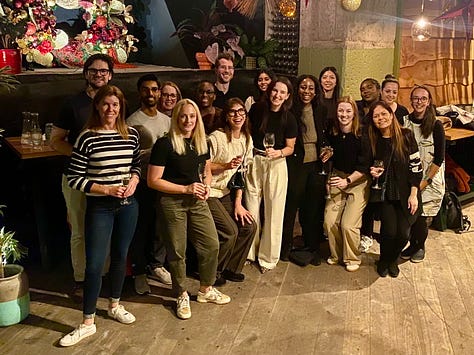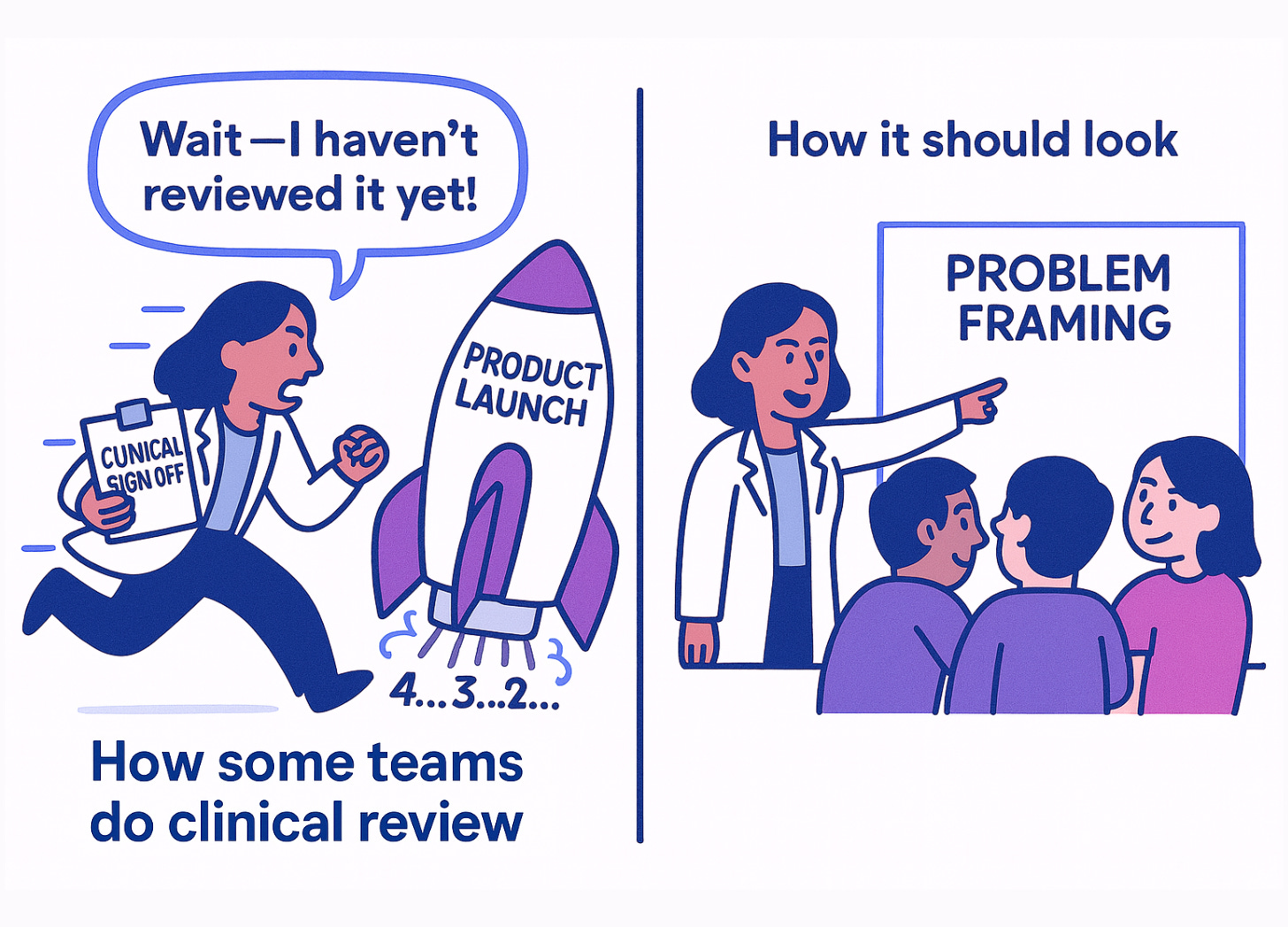5 Light Weight Ways to Apply Clinical Product Thinking... Before You Hire a CPM
Your weekly newsletter on all things clinical product and building better healthcare 🏥
This is Clinical Product Thinking 🧠, a weekly newsletter featuring practical tips, frameworks and strategies from the frontlines of clinical product. I try to make this your best Sunday afternoon email. If you enjoy it, please hit the 💜 button.
Good afternoon friends, this is issue No. 009. Today we’re diving into five lightweight ways to bring clinical product thinking into your team, before you hire your first CPM.
Most digital health companies don’t start out with a Clinical Product Manager.
Usually, there are clinicians somewhere in the org and a product team sprinting ahead at speed.
Clinical input is often sought late… right around the “ready to ship” stage and suddenly product feels blocked, clinicians feel ignored and the whole thing gets rather messy.
But here’s the thing:
You don’t need a full clinical product function to work smarter.
Here are 5 tips to bring clinical product thinking into your org today:
1. Create Guardrails, Not Gates
A big friction point?
Clinicians are being parachuted into things at the end, where they’re forced to say no.
Instead, define your red lines upfront, e.g.
Features that touch patient safety.
Any external comms that make clinical claims.
Regulated flows (prescribing, triage, data-sharing).
Those require (early… see point 4) clinical review.
Everything else? Product can move fast, as long as they record assumptions and document mitigations.
👉 This removes unnecessary handoffs while keeping true safety risks under control.
2. Make Clinician Time Predictable
Many clinicians are contributing to product “off the side of the desk.” This creates unpredictability for PMs who are trying to move at pace. If clinicians only have a day a week, make that time count.
Try:
Clinic hours: set windows each week for rapid-fire product questions.
Async template: short form + 24–48h SLA.
Slack hygiene: define what can be async vs needs a live chat.
👉 The goal is to reduce the waiting frustration and give PMs certainty in turnaround times.
3. Build an Incident → Improvement Pipeline
Clinical issues can surface from anywhere. With no clinical product function it can be tricky for product or clinicians to sort through what needs to happen and how urgently. Instead of letting issues sit in inboxes:
Clinical triage by potential severity and likelihood of occurrence.
Draft a short “clinical requirements” note (the clinical equivalent of a PRD).
Prioritise based on clinical risk.
Pass to product for roadmap slotting.
👉 This builds a direct bridge from clinical safety → product iteration.
4. Clinical Input at Outset
Clinical review shouldn’t be the final checkbox before launch. It should shape the brief. Involve clinicians early, at the problem-definition stage, not just at solution review.
Try:
Invite a clinician to every discovery sprint or problem-framing session.
Ask them to sanity-check clinical assumptions before design begins.
Use a shared brief capturing both product goals and clinical outcomes.
👉 Early input prevents late-stage blockers and saves weeks of iteration down the line.
5. Light-touch Upskilling for Clinicians
Clinicians don’t need to become PMs overnight, but shared language helps.
Run a PM 101 brown-bag: story points, definition of ready, prioritisation.
Share a quick glossary of common terms and acronyms (CAC, LTV, DAU, CPC…)
Point them to useful resources e.g. Lenny’s podcast, Hustle Badger, Mind the Product, books on key PM skills.
👉 When clinicians have deeper product understanding, everything flows a lot smoother.
Start Small, Prove It, Then Scale
You don’t need a Clinical Product Manager to get started.
Pilot these approaches with one squad and track what changes:
Fewer late-stage blockers
Faster releases
Happier clinicians and PMs
Clinical product thinking isn’t about slowing you down.
Done well, it helps you move faster with fewer risks and better outcomes.
💭 I’d love to hear how it goes — reply or comment to share.
The 1st Clinical Product Drinks 🍸
This week we had the first Clinical Product Drinks meet-up in London. Such a fun evening with 20 clinical product managers, founders and clinicians. 👇



Join the Next Event 🎇
📆 12th November - Clinical Product Dinner: Regulation Without Killing Innovation
With Dr Dom Pimenta, CEO & Founder of Tortus AI, empowering clinicians with advanced AI through their Class I medical device. Sign up here. (Last few tickets!)
Hiring Spotlight 🚀
Numan is hiring a clinical product manager focusing on obesity care. I caught up with Clinical Director Danielle Brightman, who leads the function. Numan has quietly built one of the largest and most advanced clinical product teams in the UK. This is a rare chance to see what great looks like up close. 👉 Apply here
That’s all for this week. See you next time! 👋
🤝 Work with me | 📅 Attend an event | | ✍️ Send a message
Written by Dr.Louise Rix, Head of Clinical Product, doctor and ex-VC. Passionate about all things healthcare, healthtech and clinical product (…obviously). Based in London. You can find me on Linkedin.
Made with 💜 for better, safer HealthTech.





Love this visual. It captures the reality so well. Having a proper plan in place and a clinician being part of the collaboration from the start prevents those chaotic pre–go-live sign-offs that always come back to bite.
Getting clinicians involved at the problem-framing stage means context, safety and user needs align long before launch.